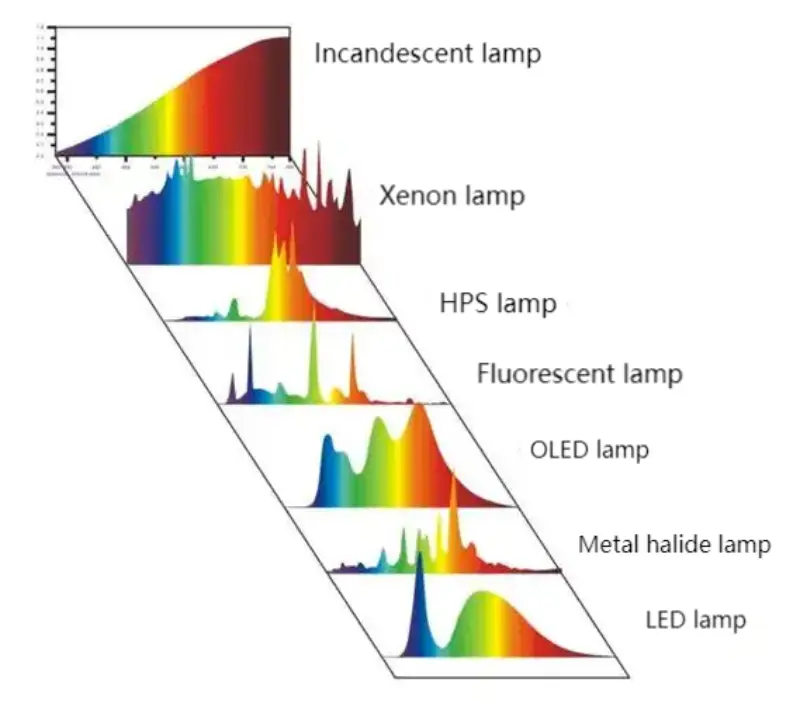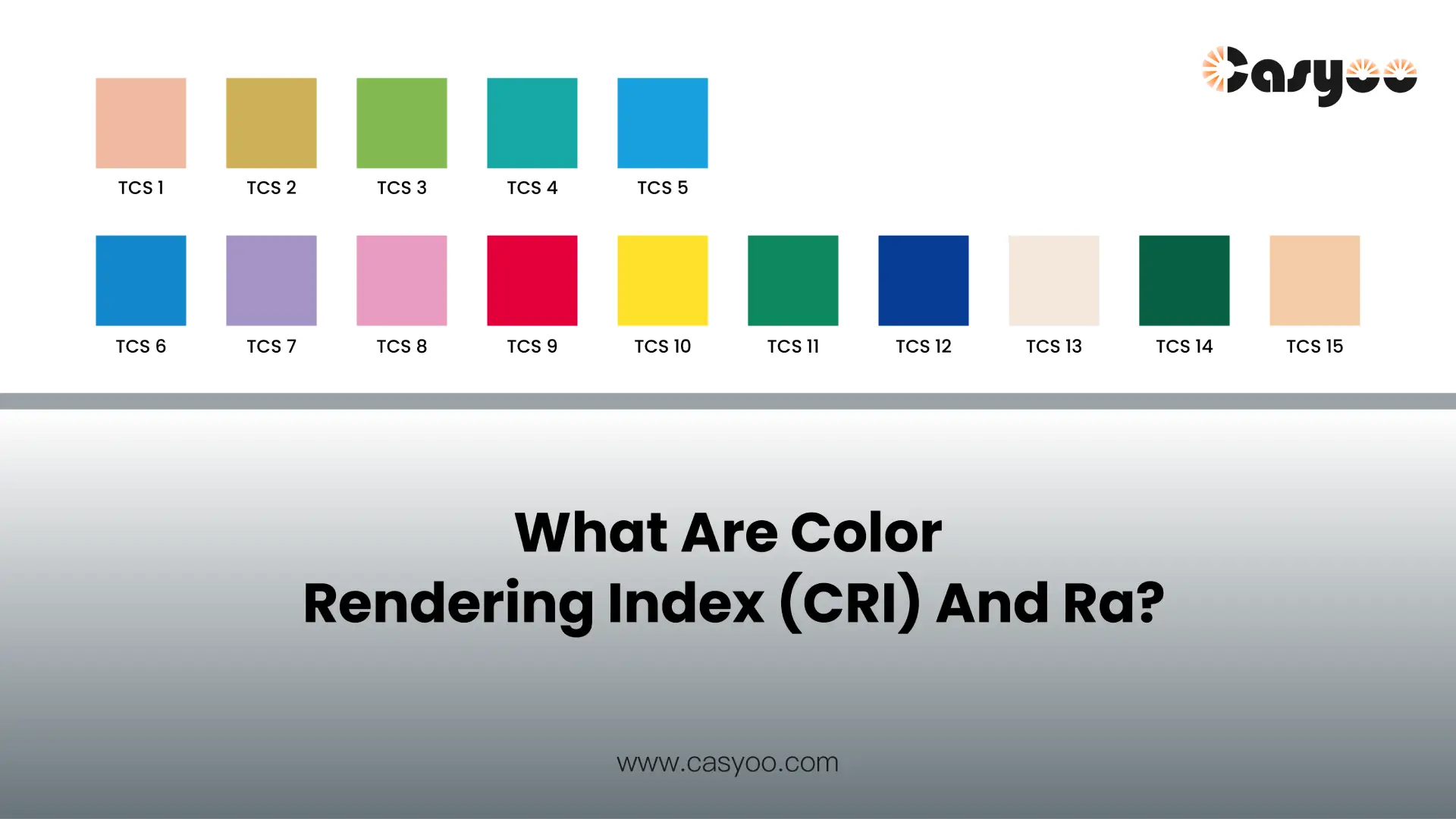Do you ever feel like the colors in a painting change when the lighting changes, or have issues shooting a product just to see the vibrancy lost? These are common problems, all too often caused by poor light quality and more precisely due to a lack of knowledge about the Color Rendering Index, or CRI. CRI is an important parameter for lights, yet someone tends to use “Ra” to replace CRI. Actually, Ra is just a method to measure CRI. Read on to know their difference and what CRI your lights should have!
What Are CRI and Ra?
CRI
CRI, which is short for Color Rendering Index, refers to a scale from 0 to 100 that describes how well a light source can render colors compared to the natural reference light, including daylight and an incandescent lamp. This index is a valuable tool for several key industries such as photography, retail, and healthcare, where color fidelity is highly essential.
Ra
Ra is a more accurate calculation of CRI. It’s the average color accuracy measure for eight predefined pastel shades, R1 through R8, also known as Test Color Samples, TCS. These colors represent tones found in nature—like muted greens and grays. While useful, Ra is not an exhaustive benchmark since it does not include saturated colors like R9, deep red, which are very important in applications such as medical diagnostics, food display, and art.
Key Differences
The difference between CRI and Ra lies in the scope. While CRI takes a very broad approach toward the methods of assessing color rendering, including extended metrics like Re, which includes all 15 test colors from pastel shades to highly saturated reds and blues, Ra narrows it down to the first eight TCS. This can result in misleading results in applications where saturated colors play a substantial role.
For instance, a light source with Ra≥80 may still poorly render deep reds (R9) and so would not be suitable for either medical or retail applications. The extended CRI methods, on the other hand, present a more holistic view of how a light performs across a full range of colors.
The Test Color Samples (TCS) and Their Importance
Test Color Samples Underpin CRI. This standard set of 15 colors allows for an indication of how well a light source is at rendering colors in comparison to a reference light. Each sample, hence, represents one specific color, ranging from soft pastels to highly saturated ones.
How TCS Testing Works
To find CRI, a light source is placed on the TCS, and the appearance of each color is compared to its appearance under the reference light. The less the departure from the reference, the higher the score. The TCS are defined as follows:
- R1-R8: These are neutral pastel colors such as grayish red and yellow-green. These scores are averaged to find Ra.
- R9-R15: These include saturated and specific colors such as deep red (R9) and Asian skin tone (R15). These colors are excluded in Ra but become crucial in applications requiring extended CRI calculations.
The Weaknesses of Ra and the Need for Extended CRI
Ra’s Weaknesses
Ra, though an enabling standard, has some glaring weaknesses. These are:
- Exclusion of Saturated Colors: Ra calculations do not take into account R9-R15, and that means colors that are greatly important in retail, arts, and healthcare.
- Simplistic Averaging: Averaging scores means that Ra can hide bad performance in individual areas. A light with Ra 80 may still have terrible reds and blues.
- Lack of Context: Since Ra does not take into account the role that correlated color temperature plays in color perception, it will not be able to show subtle applications.
Why R9 Matters
Among the TCS, R9 (deep red) is often the most critical in an enormous variety of applications, including:
- Healthcare: Accurate rendition of skin tones and blood tones for diagnostics.
- Retail: Vibrant reds make fresh produce and textiles more appealing.
- Art and Design: Faithful reproduction of artwork and materials requires precise rendition of reds.
Without considering R9, even the highest scoring Ra may not be able to respond to these demanding environments.
Extended Metrics for Better Accuracy
In order to address these gaps, lighting professionals have come to rely on metrics that go beyond Ra:
- Extended CRI (Re): Measures all 15 TCS for a more complete view of how a light performs.
- TM-30: A modern standard that breaks down color fidelity and saturation in unprecedented detail across 99 test colors.
- CQS (Color Quality Scale): CQS is an attempt to bridge the gap between technical metrics and the real-world perceptions of human visual preferences.
The Importance of High CRI in Different Applications
Photography and Film: Capturing True Colors
Lighting is an integral element in the storytelling of photographers and filmmakers. High-CRI lights mean colors are vivid and true, with less need for post-editing. This is because capturing a product’s true colors is done with light having Ra≥90, whereas low-CRI lighting distorts hues, compromising the final result.
Healthcare: Precision in Skin Tone Representation
Accuracy of lighting is not an option in medical settings—it’s a necessity. High-CRI lighting with R9 > 75 shows subtle skin details, helping to diagnose conditions such as rashes or bruises. It is on such lighting that operating rooms and clinics depend to assure clarity and improve the care of patients.
Retail: Enhancing Product Appeal
In retail environments, lighting is a direct influencer of purchases. From the rich red of fresh meat to the bright colors in a line of clothing, high CRI lighting with strong R9 and R12 performance ensures that products look their best.
Everyday Use: Elevating Spaces
Indoors, high-CRI lighting makes the environment of a space more natural and welcoming. In kitchens or living rooms, Ra ≥ 80 lights are able to show the real colors of furniture and food, improving comfort and functionality.
CRI and Light Source Types
Not all light sources are created equal when it comes to CRI. Different technologies perform differently, and knowing their strengths and weaknesses can help you make informed decisions based on your particular needs.
Common CRI Ranges
- Incandescent Bulbs: CRI 95-100, excellent color rendering but inefficient energy use.
- LED Lights: CRI is usually between 70-95 with some premium options as high as 98.
- Fluorescent Lights: CRI values run the gamut, averaging around 62 for standard tubes.
- High-Pressure Sodium Lamps: CRI can be as low as 25, which is acceptable for outdoor applications but not sufficient for color-critical applications.
Spectral Power Distribution (SPD) Matters
CRI is a useful measure, but it is not the whole story. A light source’s Spectral Power Distribution (SPD)–that is, the spread and strength of its emitted wavelengths–makes a lot of difference in how well it can render colors faithfully.
Incandescent Bulbs
Incandescent bulbs provide very good CRI of 95-100 due to their smooth, continuous spectral output. This gives very good color rendering of all colors at all wavelengths, including deep reds (R9). However, their high energy use and heat output make them impractical in today’s world.
LEDs
LEDs are flexible and energy efficient with CRI values ranging between 70 to 98 depending on the quality. High-quality LEDs with advanced phosphor coating may also have excellent color rendering performance. However, the less expensive LEDs usually have problems with saturated tones-specifically, deep reds-R9 and strong blues-R12-and thus become limited in professional applications.

Fluorescent Lamps
Fluorescent bulbs have middling CRI ratings (62-85). Their SPD is also not smooth because to phosphor coatings that leave gaps. This makes them appropriate for simple applications but not for color-critical settings such as art galleries or medical institutions.
High-Pressure Sodium (HPS) Lamps
HPS lamps are efficient, though their color rendering is rather poor: CRI values of HPS lamps can drop down to 20-25. Their narrow spectral output is dominated by yellow and orange wavelengths, better suiting them for outdoor lighting than for indoor lighting or other color-sensitive applications.
Sunlight
Sunlight is the gold standard of lighting, with a perfect CRI value of 100. The continuous and balanced spectrum makes its color accuracy unmatched, hence its role as a standard for assessing artificial sources.
Summary Table: SPD and CRI of Common Light Sources
| Light Source | CRI Range | SPD Features | Strengths | Weaknesses |
| Incandescent Bulb | 95-100 | Continuous, smooth spectrum | Excellent color rendering (R9) | Inefficient, high heat output |
| LED | 70-98 | Peaks in blue region, gaps in red and violet | Energy-efficient, customizable SPD | Potentially poor R9, blue spike issues |
| Fluorescent Lamp | 62-85 | Sharp peaks, significant spectral gaps | Cost-effective | Poor R9 performance, uneven spectrum |
| High-Pressure Sodium | 20-25 | Narrow spectrum dominated by yellow/orange | High efficiency | Very poor color rendering, no R9 |
| Sunlight | 100 | Balanced, continuous spectrum | / | / |
Practical Advice for Lighting Selection
Choosing the proper lighting can be daunting, but these tips make it easier.
Tips for Professionals
- Match CRI to the Application: Use light sources with Ra ≥ 90 for color-critical jobs, such as photography, art galleries, or retail displays. Ra ≥ 80 will typically be adequate for normal lighting in a house or business.
- Give R9 Values Priority: Because reds are essential in industries like healthcare and retail, it’s important to ensure that the light source has a R9 value greater than 75.
- Examine Extended Metrics: To obtain a more comprehensive understanding of the light’s performance, investigate metrics such as TM-30 or extended CRI for projects with particular lighting requirements.
Recommendations for Everyday Consumers
Consider these factors while choosing lights for your house or place of business:
- For general use, use LED bulbs with Ra ≥ 80 since they offer an excellent mix of efficiency and quality.
- Choose LEDs with Ra ≥ 90 for spaces like living rooms, kitchens, and other areas where color fidelity is crucial.
- Pro Tip: To make sure the light source satisfies your demands, always look at the product description or packaging for the CRI and R9 values.
The Future of Lighting: Advancing Beyond CRI
New metrics like TM-30 and sophisticated spectral designs have been made possible by evolving lighting technology, which has pushed the limits of color accuracy and visual comfort. In the future, even more accurate techniques for evaluating light quality will be available to ensure that all colors—from vivid blue to deep red—are adequately portrayed.
At Casyoo, we are proud to be at the forefront of these innovations. Our high-CRI LED lights are engineered to deliver unparalleled color rendering, meeting the demands of professionals in photography, retail, healthcare, and beyond.
Contact us for our range of premium LED solutions right now!




